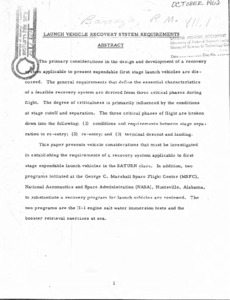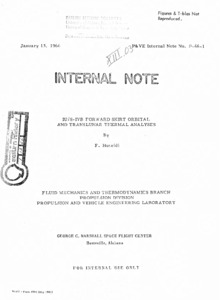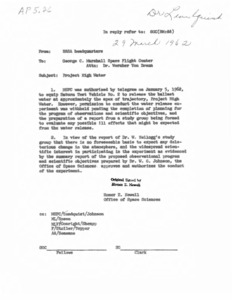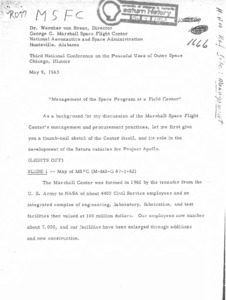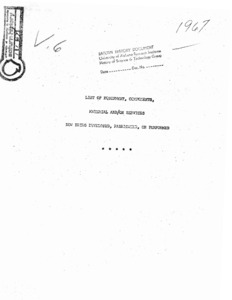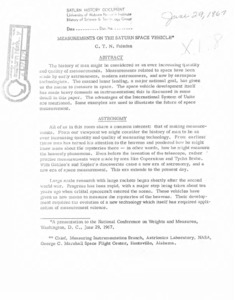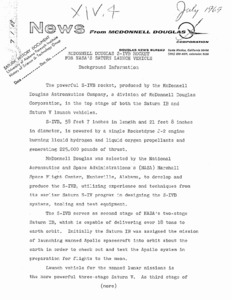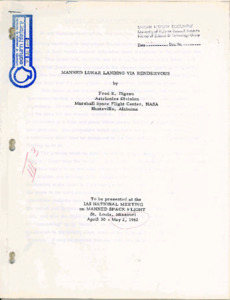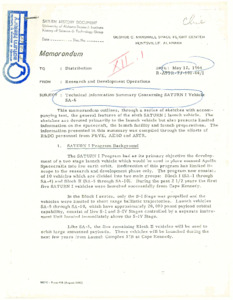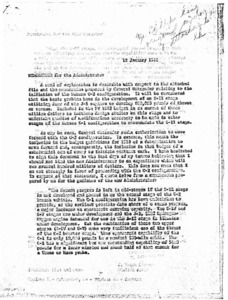
Browse Items (175 total)
Sort by:
-
"Launch Vehicle Recovery System Requirements."
The primary considerations in the design and development of a recovery system applicable to present expendable first stage launch vehicles are discussed. The general requirements that define the essential characteristics of a feasible recovery system are derived from three critical phases during flight. The degree of criticalness is primarily influenced by the conditions at stage cutoff and separation. The three critical phses of flight are broken down into the following: (1) conditions and requirements between stage separation to re-entry; (2) re-entry; and (3) terminal descent and landing. -
"IU/S-IVB Forward Skirt Orbital and Translunar Thermal Analyses."
This report determines the maximum and minimum solar and terrestrial thermal energy incident and absorbed by Saturn IB/V vehicles in earth orbit and translunar travel. The influence' of this external energy on the Instrument Unit Thermal Conditioning System performance, and consequently its adequacy to maintain the electronic packages at acceptable temperature limits is ascertained. Conclusions are: a) Methanol/water coolant temperature will deviate from 111 specifications only during translunar cold flights. However, adequate thermal conditioning of the electronic equipment would still be maintained. b) Instrument Unit missions exceeding 6 1/2 hours, or electronic packages heat dissipation magnitudes lower than 3 kw or higher than 8.5 kw, should be reviewed to ascertain thermal compatibility. -
"Project High Water."
Letter to Wernher von Braun from NASA headquarters regarding Project Highwater and how it was withheld. -
"Management of the Space Program at a Field Center."
Transcription of a presentation from Wernher von Braun discussing the roles of the space vehicles in the Apollo project. -
"List of Equipment, Components, Materials, and/or Services Now Being Developed, Fabricated or Performed."
Lists of different parts of rockets. -
"Measurements on the Saturn space vehicle."
The history of man might be considered as an ever increasing quantity and quality of measurements. Measurements related to space have been made by early astronomers, modern astronomers, and now by aerospace technologists. The manned lunar landing, a major national goal, has given us the means to measure in space. The space vehicle development itself has made heavy demands on instrumentation; this is discussed in some detail in this paper. The advantages of the International System of Units are mentioned. Some examples are used to illustrate the future of space measurement. -
"McDonnell Douglas S-IVB rocket for NASA's Saturn launch vehicle."
Press release detailing how a rocket is the top stage of both the Saturn IB and Saturn V launch vehicles. -
"Manned Lunar Landing via Rendezvous."
Paper to be presented at the IAS National Meeting on Manned Space Flight. Focuses on operations leading to injection of the space craft into the lunar transfer trajectory. -
"Memorandum : technical information summary concerning Saturn I vehicle SA-6."
This memorandum outlines, through a series of sketches with accompanying text, the general features of the sixth SATURN I launch vehicle. The sketches are devoted primarily to the launch vehicle but also presents limited information on the spacecraft, the launch facility and launch preparations. The information presented in this summary was compiled through the efforts of R&DO personnel from P&VE, AERO and ASTR. -
"Memorandum for the administrator."
Very poor photocopy. Memorandum requesting additional information regarding a file attached to this one.
